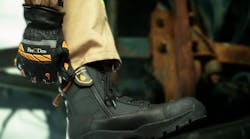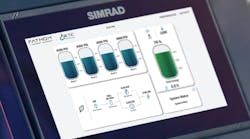This month's column draws our attention to three specific areas:
- Safe driving, road conditions and challenges in controlling the vehicle
- The seatbelt issue
- Protecting our personnel while operating on roadways
Instead of digging too deeply on the above issues, I will cover them below with some usable information, ideas and advice, then direct you to related resources where you can get sample policies, procedures and training information for your department, so you don't repeat history.
The Hamilton Township, OH, Fire Department provides emergency medical, fire and rescue services to a population of 5,000 in a 29-square-mile area. The department operates two fire stations within the township and is a part of the Franklin County/Columbus automatic mutual aid response system. Our sincere thanks to Fire Chief Jerry Lupfer, Lieutenant Kyle Witter, Firefighter Kyle Haertling, Firefighter Steve McWilliams, medic student Nicholas Adkins, and the members of the Hamilton Township Fire Department for their cooperation in sharing and passing this critical information along to the fire service.
This account is by Lieutenant Charles K. "Kyle" Witter:
My crew and I were responding to an auto crash on the very busy Interstate 270 and U.S. 23 in the south end of Columbus when the driver of our medic unit, M-171, misjudged an entrance ramp with a concrete barrier wall at the end of it, striking the wall on the driver side front corner. The collision subsequently spun us out of control and flung us into the center median, where we then flipped and came to rest on a guardrail. The driver and I were pinned (I was in the officer seat) for a short time, but were able to get free with the help of the crewmembers in the back of the medic who freed themselves. All of us were transported to Grant Medical Center in Columbus with non-life-threatening injuries.
After our crash, a Franklin County Sheriff's cruiser was struck in the rear while blocking the scene of our wreck. Thankfully, he was not in the cruiser at the time. We received word of this secondary crash while we were being transported to the hospital. The driver of the car that hit the cruiser was drunk, and this guy could have very easily hit our medic unit while we were still in the cab.
Although we are all physically OK, mentally and emotionally this incident was one heck of a wake-up call. This is going to take some time to recover from, and no matter how hard we try, this is something that just can't be dealt with using the "strange" sense of humor we firefighters have when dealing with these sorts of things.
Bottom line -- this wreck could have been much worse, possibly resulting in line-of-duty deaths, but with the use of seatbelts and quick thinking and reaction time of our brother firefighters, we all walked away and went home to kiss and hug our wives and kids.
Thanks from the bottom of my heart for the advocacy of seatbelt use on your website FireFighterCloseCalls.com and the Firehouse® Magazine Close Calls column. I sincerely believe that your diligence in these issues saved my life and probably many more to come.
This account is by Firefighter Kyle Haertling, who was in the back of M-171:
I was sitting in the airway seat and the medic student was sitting on the bench seat. I remember explaining to the medic student that just because the dispatch message was "accident with injuries," that doesn't always mean there are going to be injuries, so using dispatch information, but full verification and size-up is critical.
As we crested the hill from High Street northbound to the on ramp to 270 eastbound, the last thing I remember is a transmission saying they have multiple calls on this crash. I remember Kyle Witter, who was sitting in the "in-charge" seat, yell, "Watch out, Steve!" Then I remember being thrown against the curb door. The next thing I remember is hearing someone screaming "44" and screaming my name. I remember hearing that, but I couldn't say anything. I remember being at the front of the truck and seeing my brothers still strapped into their seatbelts and Kyle was bleeding from the head. I remember the medic crew M-4 out of the City of Columbus collaring me and putting me in the back of the medic unit, where we were then transported to Grant Medical Center. I had a hematoma to the back of my head about the size of a baseball and I had a fairly big bruise on my right thigh, about the size of an adult's hand. That is the most accurate account of what I can remember.
My memory of the event is hazy at best. To this day, I hear, see and remember new things about the crash. I do have to say that I'm so thankful that I was in the back because up to that day, I had NOT made it a habit to wear a seatbelt in any emergency apparatus. I now believe that the seatbelts saved the lives of two of my brothers that night.
This account is by Nicholas Adkins, a medic-ride-along student who was in the back of M-171:
Our unit made contact with the concrete barrier on the driver's side, sending it into a slide across the eastbound lanes headed toward the westbound lanes. After crossing the median, we hit the back of the guardrail head-on, sending it into a right-side roll. The unit rolled approximately 1½ times, landing on the driver side on the guardrail where the cab and the rear passenger compartment meet. Firefighter Kyle Haertling and I, riding in the back of the unit, were not wearing our seatbelts. When the medic was rolling, it seemed as if it were in slow motion. Everything from inside the cabinets was flying around along with Firefighter Haertling and I colliding with each other.
When the unit stopped rolling, Firefighter Haertling and I exited the rear of the medic, then proceeded to the front of the medic to assess the status of officer Kyle Witter and driver Steve McWilliams. They were both coherent and exited the vehicle through the opening where the front windshield once was. We then set ourselves upon the guardrail and awaited oncoming medics for transport. Kyle Witter and I were transported in the same medic unit to Grant Medical Center. With no injuries and a brief lookover, I later received a $700 medical bill from the same hospital where I was attending as a medic program student! Things could have been much worse.
This account is by Firefighter Steve McWilliams, the driver of M-171:
The weather was cold with freezing rain with reports of black ice in spots. Although responding with lights and siren, speed was reduced due to weather conditions. As the medic unit proceeded down on ramp and started to merge onto 270, M-171 slid and struck approximately the last 10 feet of a concrete barrier. This barrier had no reflectors of any kind and with weather conditions that night was not easily seen. The medic unit slid across three lanes of highway and into center median strip, flipped and came to rest on driver's side down and on the guardrail. Although four personnel were on board, all four went to the ER, released that night with only bumps and bruises. All were back on duty next shift. No other vehicles were involved.
These comments are based on Chief Goldfeder's observations and communications with the writer regarding this month's close call:
- "Back of the ambulance" seatbelt use. Generally speaking, and not specific to this close call, the debate on personnel being buckled up in fire-EMS transport units is not a new one. While we understand there are some circumstances when members cannot be belted in while working in the back with a patient, those situations are, or should be, rare. And even so, some jurisdictions have designed patient areas where patient care is conducted while all are still secure. Clearly, that is a challenge. Perhaps then, if EMS personnel in the back of the unit cannot be secured, maybe the unit awaits transport until the patient is stable, or when the driver must head to the hospital before the patient is stable, the driver of the unit drives knowing that the personnel in the back are not secured and must be driven with great care and caution to minimize the potential of a crash.
Research has shown (information from Les Becker, Fire Chief Magazine, August 2007) that if you are involved in a crash while riding unrestrained in the back of an ambulance, the risk of a fatality versus no injury was more than five times greater than for front-seat occupants. Unrestrained rear ambulance occupants involved in a crash had a nearly four times greater chance of being killed than did restrained occupants. Unrestrained occupants involved in a crash had a nearly 6 ½ times greater risk of suffering an incapacitating injury than did restrained ambulance occupants. So, think! Make sure your all personnel are buckled in. In those very rare times when you feel there are no other options, and when your fire department standard operating procedures (SOPs) dictate, respond to the hospital with extreme caution knowing those in the back are not buckled in. Drive the way you would want to be driven if you were in the back providing patient care. Slow down. Use extreme caution. Slow down even more.
In this month's close call, the driver and the officer, riding up front, were very fortunately buckled in, which probably saved them from an ejection at the very least. Their intentional use of seatbelts probably saved their lives. The personnel in the back of the medic weren't buckled in and they could have been much more severely injured than they were. All too often, in nearly every fire department or EMS agency, the personnel in the back are not secure. Our above comments related to patient care cover the seatbelt issue for that situation. However, when there are no patients in the back, there is no excuse for everyone to not be belted in.
- Driving emergency apparatus. Some outstanding resources are available to fire and EMS agencies related to the safe operations of emergency vehicles. And while we are providing links to some of what we consider the best, the fire chief and local and state laws set the standard for how a firefighter or EMT who is privileged to drive, will drive. Policies (as opposed to guidelines) must be set by the chief in cooperation with the department attorneys and state law. And once the policy is set -- and all members who are qualified to be trained on it, become trained on it -- it then becomes the company officer's responsibility to enforce the policy -- equally and across the board. There should be absolutely no gray area in relation to the department's policy on hot/cold responses, vehicle speed, stopping at red traffic signals, stopping at stop signs and operating the vehicle in general. Additionally, a clear policy must be set, trained upon and enforced providing details as to when an ambulance may transport "lights and sirens" and when it will transport routine.
Here are several excellent websites that can provide you with related information:
IAFF EMERGENCY VEHICLE SAFETY PROGRAM:
http://www.usfa.dhs.gov/fireservice/research/safety/vehicle.shtm
USFA EMERGENCY VEHICLE SAFETY INFORMATION
http://www.iaff.org/hs/EVSP/home.html
- Protecting our personnel on the roadway. As far as we are concerned, the best resource (with the most current information related to new laws and regulations) for firefighters and EMS personnel related to risk-managed operations on roadways is ResponderSafety.com. Additionally, even the NFPA standards cover our safety on roadways. As stated in NFPA 1451 (8.1.4.1), "fire service vehicles shall be utilized as a shield from oncoming traffic wherever possible." Sometimes, a few flares, some cones and police cars are not enough to insure the protection of firefighters, EMS personnel and police officers. Secondary crashes happen regularly and have resulted in line-of-duty deaths of firefighters, EMTs and police officers. The fire chief must set direction, policy, procedures and enforcement to ensure the minimum risk to their members.
Pre-incident planning that includes agreements formed by all involved parties who may work with us on roadways such as mutual aid fire departments, EMS companies, police and highway departments can make a huge difference in how the incident is managed. Great examples of SOPs for fire departments operating on roadways are available at www.respondersafety.com. We also recommend these sites:
NIOSH TRAFFIC HAZARDS TO FIREFIGHTERS:
www.cdc.gov/niosh/hid12.html
HIGHWAY INCIDENT SAFETY FOR EMERGENCY RESPONDERS:
www.lionvillefire.org/hwy_safety/index.htm
(Secondary crash LODD case study information)
In this month's close call, a combination of events, including vehicle control and road conditions, seatbelt use/non-use and protecting the scene of a roadway incident provides numerous opportunities for us to learn. The Hamilton Township firefighters survived this crash and decided to share their story with us. Their intent is for us to take it and learn from what they went through so it doesn't happen to us. Brother/sisterhood defined.
WILLIAM GOLDFEDER, EFO, a Firehouse® contributing editor, is a 33-year veteran of the fire service. He is a deputy chief with the Loveland-Symmes Fire Department in Ohio, an ISO Class 2 and CAAS-accredited department. Goldfeder has been a chief officer since 1982, has served on numerous IAFC and NFPA committees, and is a past commissioner with the Commission on Fire Accreditation International. He is a graduate of the Executive Fire Officer Program at the National Fire Academy and is an active writer, speaker and instructor on fire service operational issues. Goldfeder and Gordon Graham host the free and noncommercial firefighter safety and survival website www.FirefighterCloseCalls.com. Goldfeder may be contacted at [email protected].





